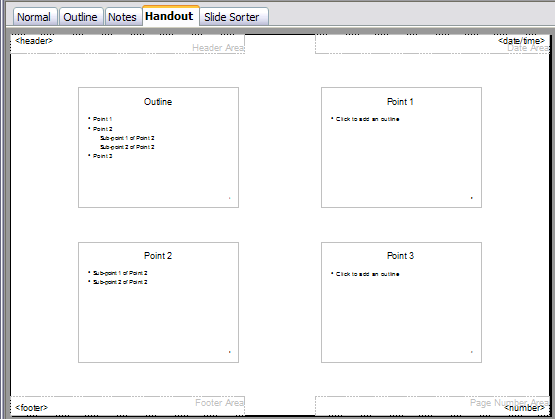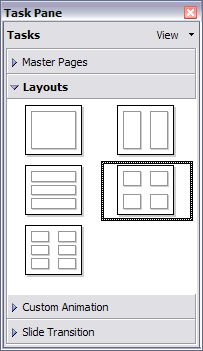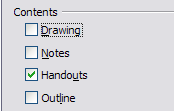Documentation/OOoAuthors User Manual/Impress Guide/Creating handouts
Creating handouts
A handout is a special view of the presentation suitable to be printed and distributed to the audience. Each handout page contains from one to six thumbnails of the slides so that the audience can follow what is presented as well as use it as reference. This section explains how to customize the handout page, an example of which is given below.

Figure 18: Example of handout with four slide thumbnails.
Note that the handout view consists of only one page regardless of the number of slides that compose the presentation.
Changing the layout
When creating handouts, first decide how many slide thumbnails you want printed on each handout page.
- Select the Handout view either by clicking on the tab in the work area or by selecting View > Handout Page from the menu bar.
- If the Task pane is not visible, select View > Task Pane from the menu bar. Tip: As for any other toolbar, you can undock the Task pane by holding down the Control key and double-clicking on an empty part of the pane.
- In the Task pane select the Layouts tab, which looks like the figure below in Handout view.
- Choose the preferred layout. The main work area changes to reflect the choice.

The available layouts for handouts in the Task Pane.
Formatting handouts
You can format several aspects of the handout, from the page style to the elements that appear on the page. You cannot format individual handout pages; any changes apply to all handouts in the presentation file.
Formatting the page
To format the handout pages:
- Be sure you are in Handouts view. (Click the Handouts tab in the work area or select View > Handout Page from the menu bar.)
- Select Format > Page from the main menu, or right-click on the handout and select Slide > Page Setup from the pop‑up menu.
- On the Page Setup dialog, set the paper size, orientation (portrait or landscape), margins, and other parameters.
- Click OK to close the dialog.
Setting automatic layout options
In Handout view, as in Notes view, Impress creates four areas where you can put information about the presentation:
- Header area
- Date and Time area
- Footer area
- Slide number area
The way to access and customize these areas is the same as for the Notes and uses the same dialog. Refer to Setting automatic layout options for information.
Note: The information in these areas does not show in Handout view, but it does appear correctly on the printed handouts.
Moving thumbnails and adding graphics
You can move (but not resize) the slide thumbnails and add lines, boxes, and other graphic elements to the handouts. The figure below shows an example. See Chapter 5 (Creating Graphic Objects) for instructions on using the graphics tools.
Tip: After designing a handout, you may wish to save it in a template so you can reuse it whenever you want. See “Working with templates” in Chapter 2 (Using slide masters, styles and templates) for instructions on saving templates and starting a new presentation from a template.
Caution: If you click on one of the other handout layouts and then return to the one you have reformatted, the slide thumbnails return to their original positions, although any lines or other graphics you have added remain where you put them. You will need to move the thumbnails back to where you want them.
Printing handouts
- Choose File > Print from the menu bar.
- Click the Options button on the Print dialog.
- In the Contents section of the Printer Options dialog, make sure that only the Handouts checkbox is selected.
- Click OK to save the change and return to the Print dialog.
- On the Print dialog, you can select which slides to include in the handouts. In the Print range section, select Pages and specify the slide numbers to be included. Any numbers entered here correspond to slides, not pieces of paper.

Select Handouts for printing.

Choose which slides to print.
For more about printing slides, notes, and handouts, see Chapter 10.
Note: At present there is no way to export handouts to PDF.
| Content on this page is licensed under the Creative Common Attribution 3.0 license (CC-BY). |
